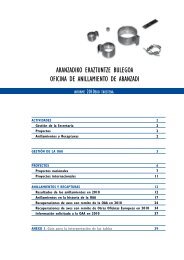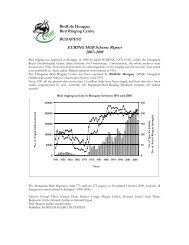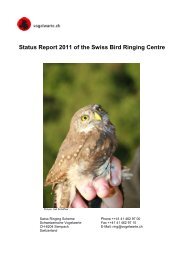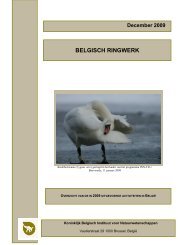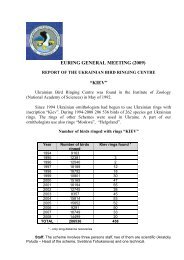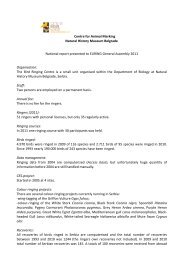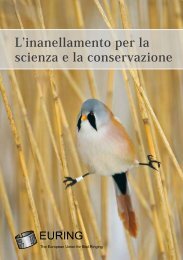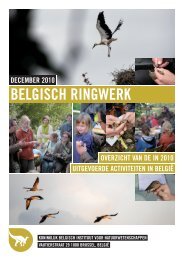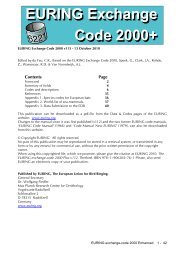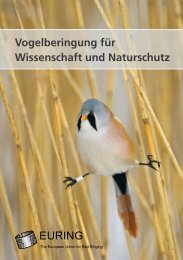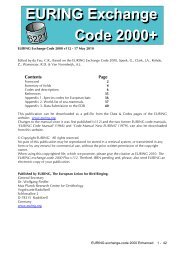The quantitative study of marked individuals in ecology, evolution ...
The quantitative study of marked individuals in ecology, evolution ...
The quantitative study of marked individuals in ecology, evolution ...
Create successful ePaper yourself
Turn your PDF publications into a flip-book with our unique Google optimized e-Paper software.
EURING 2003 Radolfzell<br />
the effects <strong>of</strong> spr<strong>in</strong>g snow cover and a spr<strong>in</strong>g conservation hunt on breed<strong>in</strong>g propensity<br />
us<strong>in</strong>g a weighted least squares approach. We also used an empirical variancecomponents<br />
approach and determ<strong>in</strong>ed that true temporal variation <strong>in</strong> breed<strong>in</strong>g propensity<br />
was considerable (mean breed<strong>in</strong>g propensity: 0.574 [95% CI consider<strong>in</strong>g only<br />
process variation: 0.13 to 1]). Spr<strong>in</strong>g snow cover was negatively related to breed<strong>in</strong>g<br />
propensity (βsnow = -2.05 ± 0.96 SE) and tended to be reduced <strong>in</strong> years with a spr<strong>in</strong>g<br />
hunt (β = -0.78 ± 0.35). Nest densities on the breed<strong>in</strong>g colony and fall young/adult ratio<br />
were good <strong>in</strong>dices <strong>of</strong> breed<strong>in</strong>g propensity, with nest densities be<strong>in</strong>g slightly more<br />
precise. <strong>The</strong>se results suggest that environmental conditions and disturbance encountered<br />
dur<strong>in</strong>g the pre-breed<strong>in</strong>g period can have a significant impact on productivity<br />
<strong>of</strong> Arctic-nest<strong>in</strong>g birds.<br />
09:20 - 09:45 AM<br />
Earlier recruitment or earlier death? On assumptions <strong>of</strong> homogeneous survival rates<br />
<strong>in</strong> capture-recapture models to estimate recruitment<br />
Emmanuelle Cam, Evan Cooch & Jean-Yves Monnat<br />
Realized patterns <strong>of</strong> age <strong>of</strong> recruitment observed <strong>in</strong> the breed<strong>in</strong>g segment <strong>of</strong> populations<br />
are governed by the product <strong>of</strong> two demographic components: [survival probability<br />
from birth to age ]*[transition probability from state prebreeder to state first-time<br />
breeder at age ]. To aga<strong>in</strong> <strong>in</strong>sight <strong>in</strong>to selective pressures shap<strong>in</strong>g age <strong>of</strong> recruitment,<br />
one may address temporal variation <strong>in</strong> age <strong>of</strong> first breed<strong>in</strong>g and covariation with population<br />
size or social and environmental factors. This <strong>in</strong>volves comparison among<br />
"groups" (e.g., cohorts) <strong>of</strong> <strong><strong>in</strong>dividuals</strong> encounter<strong>in</strong>g different environmental conditions<br />
when they reach a given age as prebreeders.<br />
However, measures <strong>of</strong> recruitment based exclusively on data from the breed<strong>in</strong>g segment<br />
<strong>of</strong> the population ignore the size <strong>of</strong> the pool <strong>of</strong> prebreeders (as opposed to transition<br />
probability). However, <strong>in</strong> a large number <strong>of</strong> species with deferred breed<strong>in</strong>g, <strong><strong>in</strong>dividuals</strong><br />
are not encountered prior to breed<strong>in</strong>g. Approaches to estimat<strong>in</strong>g age-specific<br />
recruitment probability <strong>in</strong> the absence <strong>of</strong> data from prebreeders us<strong>in</strong>g mark-recapture<br />
have been developed (Pradel and Lebreton 1999, Schwarz and Arnasson 2001, Williams<br />
et al. 2002). Unless the survival component <strong>of</strong> realized age-specific recruitment<br />
rates is known to be identical among the groups compared, <strong>in</strong>ferences about the<br />
"cause" <strong>of</strong> variation <strong>in</strong> realized age <strong>of</strong> first breed<strong>in</strong>g among groups are difficult: such<br />
differences may <strong>in</strong> fact result from differences <strong>in</strong> survival probability before <strong><strong>in</strong>dividuals</strong><br />
make the transition between states. Inferences about differences <strong>in</strong> realized recruitment<br />
rates among groups exclusively based on data from the breed<strong>in</strong>g segment <strong>of</strong><br />
the population reflect differences <strong>in</strong> recruitment probability under the assumption that<br />
there is no difference <strong>in</strong> prebreeder survival among these groups.<br />
We assessed the consequences <strong>of</strong> violations <strong>of</strong> this assumption on our perception <strong>of</strong><br />
age-specific realized recruitment rates us<strong>in</strong>g numerical simulations; the scenarios<br />
considered correspond to various biological hypotheses about group-specific variation<br />
<strong>in</strong> survival and transition probabilities. Data were simulated under regular multistate<br />
models (Nichols and Kendall 1995) and truncated <strong>in</strong>dividual histories were then analyzed<br />
us<strong>in</strong>g the reverse-time approach (Pradel 1996) and the approach developed by<br />
Schwarz and Arnasson (2001). Depend<strong>in</strong>g on the scenario, realized recruitment was<br />
delayed or advanced compared to the underly<strong>in</strong>g pattern <strong>of</strong> age-specific transition<br />
probabilities. We also addressed age-specific recruitment probability <strong>in</strong> a long-lived<br />
seabird species, the kittiwake (Rissa tridactyla) us<strong>in</strong>g a data set <strong>in</strong>clud<strong>in</strong>g data from<br />
prebreeders. We compared results from the reverse-time approach and the multistate<br />
approach, and showed that transition probability directly estimated or derived from<br />
7



